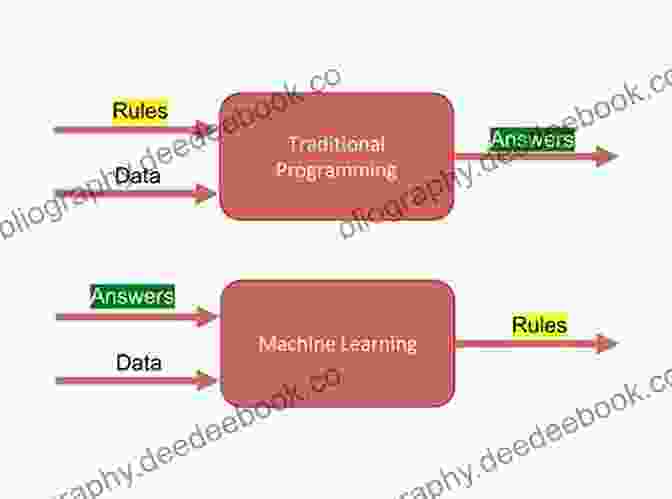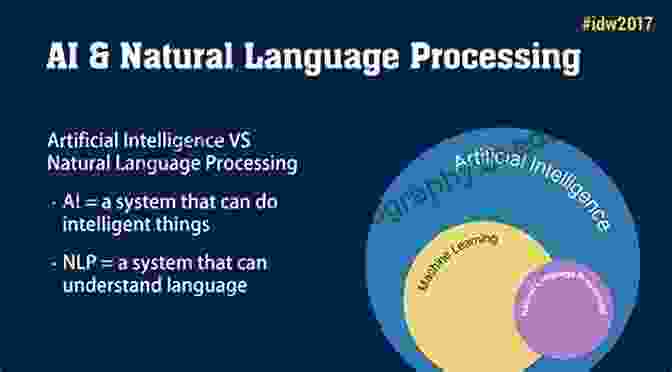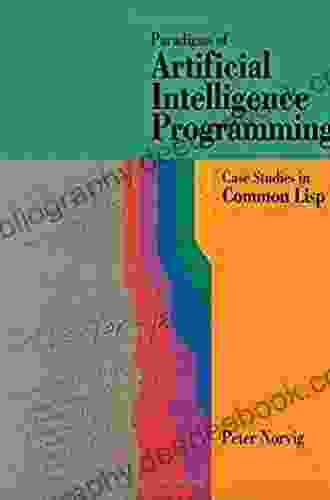Paradigms of Artificial Intelligence Programming: Unveiling the AI Toolkit

Artificial intelligence (AI) has emerged as a transformative force, revolutionizing industries and empowering us with unprecedented capabilities. At the heart of AI lies programming, the art of translating concepts into executable instructions that guide intelligent systems. To navigate the vast landscape of AI programming, it is essential to understand the different paradigms that shape its development.
4.7 out of 5
| Language | : | English |
| File size | : | 6262 KB |
| Text-to-Speech | : | Enabled |
| Screen Reader | : | Supported |
| Enhanced typesetting | : | Enabled |
| Print length | : | 953 pages |
In this article, we will explore the major paradigms of AI programming, examining their distinct approaches, strengths, and applications. By delving into each paradigm, we will gain a comprehensive understanding of the AI toolbox, enabling us to effectively develop and deploy intelligent systems.
Machine Learning

Machine learning is a subfield of AI that focuses on training algorithms to learn from data. Unlike traditional programming, which relies on explicit rules and instructions, machine learning algorithms discover patterns and insights from data, adapting their behavior based on observed relationships.
Machine learning techniques are widely used in tasks involving prediction, classification, and clustering. Some common machine learning algorithms include:
- Supervised learning: The algorithm learns from a labeled dataset, where each data point has an associated output. Example: Training a spam filter to identify spam emails.
- Unsupervised learning: The algorithm learns from an unlabeled dataset, identifying patterns and structures without predefined outputs. Example: Clustering customers based on their purchase history.
- Reinforcement learning: The algorithm learns through trial and error, receiving rewards or penalties for its actions in a dynamic environment. Example: Training a robot to navigate a maze.
Expert Systems

Expert systems are knowledge-based systems that encode the knowledge and reasoning processes of human experts. They leverage a set of rules and facts to solve problems or make decisions within a specific domain.
Expert systems find applications in areas where deep expertise is required, such as medical diagnosis, legal reasoning, and financial planning. They augment human expertise by providing consistent and reliable advice, reducing errors, and speeding up decision-making.
Expert systems typically consist of the following components:
- Knowledge base: A repository of facts and rules representing the expert's knowledge in a specific domain.
- Inference engine: A mechanism that applies the rules to the knowledge base to derive new s and make decisions.
- User interface: A means for users to interact with the system, pose queries, and receive explanations.
Natural Language Processing (NLP)

Natural language processing (NLP) is a field of AI that deals with the interaction between computers and human (natural) languages. NLP algorithms enable computers to understand, interpret, and generate text and speech.
NLP has numerous applications, including:
- Machine translation: Automatically translating text from one language to another.
- Sentiment analysis: Determining the sentiment expressed in a piece of text, such as positive, negative, or neutral.
- Chatbots: Simulating human conversations through automated text or speech responses.
NLP algorithms often employ techniques such as:
- Lexical analysis: Breaking down text into its individual words (lexemes).
- Syntactic analysis: Determining the grammatical structure of a sentence.
- Semantic analysis: Understanding the meaning of words and sentences.
Computer Vision

Computer vision is a subfield of AI that deals with the interpretation of digital images and videos. Computer vision algorithms enable computers to "see" and understand the content of visual data, extracting meaningful information.
Computer vision finds applications in areas such as:
- Object detection: Identifying and locating objects in images or videos.
- Image recognition: Classifying images into predefined categories.
- Facial recognition: Identifying individuals based on their facial features.
Computer vision algorithms often employ techniques such as:
- Image segmentation: Dividing an image into different regions based on their visual properties.
- Feature extraction: Identifying and extracting relevant features from images.
- Pattern recognition: Classifying images based on their extracted features.
Robotics

Robotics is a field of AI that deals with the design, construction, operation, and application of robots. Robotics combines elements of AI, computer science, mechanical engineering, and electrical engineering to create machines that can perform tasks autonomously or semi-autonomously.
Robots have numerous applications, including:
- Industrial automation: Performing repetitive tasks in manufacturing and assembly lines.
- Service robotics: Providing assistance in healthcare, retail, and customer service.
- Space exploration: Conducting scientific research and missions in remote and dangerous environments.
Robotics algorithms often employ techniques such as:
- Motion planning: Determining the optimal path for a robot to move from one point to another.
- Control theory: Regulating and maintaining the robot's behavior.
- Sensing and perception: Using sensors to gather information about the environment and make decisions.
The paradigms of artificial intelligence programming provide a diverse toolkit for developing intelligent systems. Each paradigm offers its own strengths and applications, allowing us to tackle a wide range of problems and create innovative solutions.
By understanding the different AI programming paradigms, we can make informed choices about which ones to leverage for specific tasks. This empowers us to develop intelligent systems that enhance our abilities, automate processes, and drive progress across industries.
As the field of AI continues to advance, we can expect to see the emergence of new paradigms and the further refinement of existing ones. The future of AI programming holds exciting possibilities, and by embracing the diverse paradigms available, we can shape this future and harness the full potential of this transformative technology.
4.7 out of 5
| Language | : | English |
| File size | : | 6262 KB |
| Text-to-Speech | : | Enabled |
| Screen Reader | : | Supported |
| Enhanced typesetting | : | Enabled |
| Print length | : | 953 pages |
Do you want to contribute by writing guest posts on this blog?
Please contact us and send us a resume of previous articles that you have written.
 Page
Page Chapter
Chapter Reader
Reader Library
Library Paperback
Paperback Magazine
Magazine Newspaper
Newspaper Paragraph
Paragraph Sentence
Sentence Bookmark
Bookmark Foreword
Foreword Annotation
Annotation Scroll
Scroll Codex
Codex Tome
Tome Bestseller
Bestseller Library card
Library card Narrative
Narrative Biography
Biography Autobiography
Autobiography Memoir
Memoir Reference
Reference Encyclopedia
Encyclopedia Thesaurus
Thesaurus Narrator
Narrator Character
Character Catalog
Catalog Card Catalog
Card Catalog Periodicals
Periodicals Scholarly
Scholarly Reserve
Reserve Reading Room
Reading Room Special Collections
Special Collections Interlibrary
Interlibrary Dissertation
Dissertation Storytelling
Storytelling Awards
Awards Reading List
Reading List Book Club
Book Club Theory
Theory Godfrey Hutchinson
Godfrey Hutchinson Nicole Casey
Nicole Casey Chris Ellis
Chris Ellis Thomas Johnson
Thomas Johnson Petru Popescu
Petru Popescu Ann B Ross
Ann B Ross Susan Blumenthal
Susan Blumenthal Cinders Mcleod
Cinders Mcleod Cedric De Coning
Cedric De Coning Nathan Van Coops
Nathan Van Coops Ralf Rothmann
Ralf Rothmann Bruce F Katz
Bruce F Katz John H Tullock
John H Tullock Keith Sweat
Keith Sweat L Ron Hubbard
L Ron Hubbard Clint Stoker
Clint Stoker Hilton L Root
Hilton L Root William Carlos Williams
William Carlos Williams Christophe Levaux
Christophe Levaux J E Feldman
J E Feldman
Light bulbAdvertise smarter! Our strategic ad space ensures maximum exposure. Reserve your spot today!

 William PowellNovel Artificial Neurons and Neural Structures to Control Autonomous Robots
William PowellNovel Artificial Neurons and Neural Structures to Control Autonomous Robots
 Billy PetersonUnraveling the Enigmatic Country House Mystery of the 1920s: The Mr. Quayle...
Billy PetersonUnraveling the Enigmatic Country House Mystery of the 1920s: The Mr. Quayle...
 Eugene PowellComplete Owner's Guide: Acquisition, Cost, Care, Proper Health, and Diet for...
Eugene PowellComplete Owner's Guide: Acquisition, Cost, Care, Proper Health, and Diet for... Jim CoxFollow ·5.1k
Jim CoxFollow ·5.1k Charlie ScottFollow ·6k
Charlie ScottFollow ·6k Ernest PowellFollow ·12.8k
Ernest PowellFollow ·12.8k Eric HayesFollow ·16.1k
Eric HayesFollow ·16.1k Wayne CarterFollow ·17.3k
Wayne CarterFollow ·17.3k Kenzaburō ŌeFollow ·2k
Kenzaburō ŌeFollow ·2k Bryson HayesFollow ·8.6k
Bryson HayesFollow ·8.6k Shannon SimmonsFollow ·17.7k
Shannon SimmonsFollow ·17.7k

 Braden Ward
Braden WardFeminism's Forgotten Fight: The Ongoing Battle for...
The feminist movement has historically...

 Julio Cortázar
Julio CortázarBlue Heaven Black Night: A Literary Journey Through Love,...
In the realm of...

 Eddie Bell
Eddie BellA Journey Through Time: Exploring the Enchanting World of...
The vibrant tapestry of New...

 Lawrence Bell
Lawrence BellValiance Dragon Soul Press Anthology: A Literary Odyssey...
Step into a realm where...

 Aron Cox
Aron CoxEmbark on a Creative Odyssey with Jean Leinhauser's "101...
Unveil a Kaleidoscope of...
4.7 out of 5
| Language | : | English |
| File size | : | 6262 KB |
| Text-to-Speech | : | Enabled |
| Screen Reader | : | Supported |
| Enhanced typesetting | : | Enabled |
| Print length | : | 953 pages |







